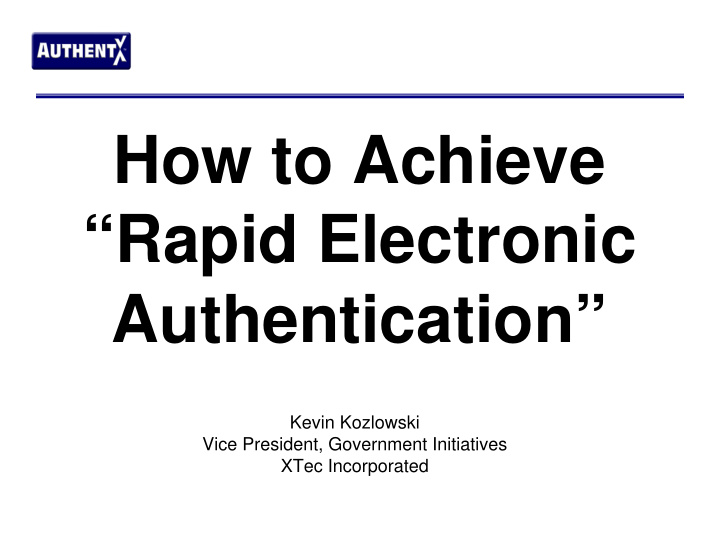



How to Achieve “Rapid Electronic Authentication” Kevin Kozlowski Vice President, Government Initiatives XTec Incorporated
Technical Ramifications of 800-116 � XTec has been a leader in Smart Card Physical Access Control for over 15 years, � We understand the technology as well as the challenges surrounding the technology. � We also understand that interoperability is not a new concept nor is it a reach in our current environment. Interoperability was achieved a long time ago through the GSC-IS standards. � What you will see here is The Interagency Interoperability Task Force’s Demonstration on Smart Card Interoperability for Physical Access Control which took place back in 2003. � See Video
Technical Ramifications of 800-116 • As you can see, The question is not whether or not interoperability can be achieved. • The Question is…. How do we make interoperability secure with “rapid authentication”? • In the Physical Access World we all know that if transaction time is longer than 2 seconds people will find the reason to not use authentication thus making for a less secure system.
Authentication Factors • Authentication is accomplished by verifying one or more factors: – Objects that can be presented: tokens , cards etc. – Secret items that are known: passwords, PINs etc. – Personal characteristics: biometrics, portrait, etc • Simply establishing that an ID Number or Credential is valid is not authentication, especially in the case of published data such as PKI certificates.
Technical Ramifications of 800-116 • Lets take a look at another production environment. Which shows true interoperability with “rapid authentication”. • GSA Region 1 has set up the Physical Security Infrastructure so as to allow the use of PIV II cards to be used for access to the building.
Technical Ramifications of 800-116 • The GSA identification cards issued nationwide starting in 2004 and the GSA Region 1 Access Control System, supported high assurance profile utilizing symmetric keys and has been in use since the summer of 2006.
Technical Ramifications of 800-116 • For the user to gain access to a control point (turnstile, door, elevator floor, etc) the card must have the proper authentication key (in the 9E container as specified in FIPS 201) as well as an active permission for that reader on the PACS system. • If the card cannot be authenticated the user will get an authentication failed or access denied indication. • Presently GSA Region 1 has tenants with PIV cards issued by the Department of State, Department of Labor, and the Peace Corps that meet the criteria.
PIV Authentication Factors Independent Authentication Factors Dependent Authentication Factors User PIN X.509 Certificate Key 9E Key 9E PIN for PIV Card Authentication PKI Symmetric Special Command 5FC101 – Optional PIV Authentication Certificate Key 9A X.509 Certificate for PIV Authentication PKI 5FC105 - Mandatory Card Holder Fingerprints CBEFF + Signed Data Object 5FC103 - Mandatory X.509 Certificate for Digital Signature Key 9C 5FC10A – Optional PKI Card Holder Facial Image (Portrait) X.509 Certificate for Key Management Key 9D CBEFF + Signed Data Object Escrow ? - 5FC10B – Optional PKI 5FC108 – Optional Something I Have which is capable of Something I Know or Something I am being authenticated by itself which is reliant on another factor
• Using a PKI cert and asymmetric key for the card authentication 9E key is redundant since that function can already be accomplished better with the mandatory PIV Authentication Certificate, and asymmetric 9A key.
• In August 2004 HSPD-12 called for: – 3) "Secure and reliable forms of identification" for purposes of this directive means identification that (a) is issued based on sound criteria for verifying an individual employee's identity; (b) is strongly resistant to identity fraud, tampering, counterfeiting, and terrorist exploitation; (c) can be rapidly authenticated electronically ; and (d) is issued only by providers whose reliability has been established by an official accreditation process. • Excerpt from HSPD-12 by George W. Bush August 27, 2004
PIV Authentication Key Generation Block 1: 16 Bytes FASC-N: 25 Bytes GUID: 16 Bytes Exp Date: 8 Bytes Pad (00) 15 Bytes Block 1: 16 Bytes Block 2: 16 Bytes Block 3: 16 Bytes Block 4: 16 Bytes AES – ECB Issuer PIV Auth Key Encrypt Block 2: 16 Bytes AES – ECB Issuer PIV Auth Key Encrypt Block 3: 16 Bytes PIV PIV 9E Authentication Key 9E Authentication Key AES – ECB Issuer PIV Auth Key Encrypt Block 4: 16 Bytes AES – ECB Issuer PIV Auth Key Encrypt
Conclusion • XTec proposes that the 9E key be symmetric and mandatory in following the PAIIWG TIG 2.3 guidelines which allow for card and data authentication in a single transaction. • This proposal is a proven method to allow the standards to meet the “ rapidly authenticated electronically” aspect of the presidential directive
XTec Incorporated Corporate Offices 5775 Blue Lagoon Drive, Suite 280 Miami, Florida 33126 Tel: (305) 265-1565 Fax: (305) 265-1569 Government Division 11400 Commerce Park Drive, Suite 210 Reston, Virginia 20191 Tel: (703) 547-3524 Fax: (703) 547-3533 www.xtec.com E-Mail info@xtec.com Tom Murphy Kevin Kozlowski Director of Sales Vice President Government Initiatives 703-547-3528 703-547-3524 Tmurphy@xtec.com Kkozlowski@xtec.com
Recommend
More recommend